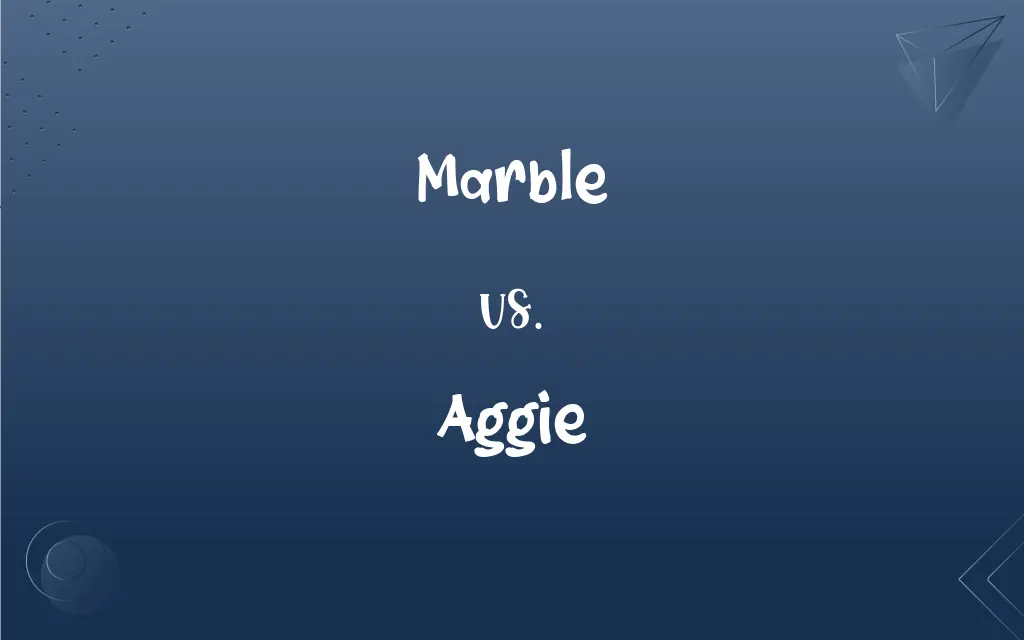Marble vs. Aggie: What's the Difference?
By Janet White & Harlon Moss || Updated on May 23, 2024
Marble is a small, round toy typically made of glass or stone, used in children's games. Aggie specifically refers to a type of marble made from agate or a glass marble that resembles agate.

Key Differences
Marble is a general term for small, round toys made from various materials like glass, stone, or clay, used in games and for decorative purposes. They come in various colors, patterns, and sizes, and are often collected by enthusiasts. Aggie, on the other hand, is a specific type of marble originally made from agate, a semi-precious stone. Today, it also refers to glass marbles that mimic the appearance of agate with their characteristic swirls and patterns.
Marbles have been used in various traditional children's games where players try to knock each other's marbles out of a designated area. These games require skill and precision, and the marbles themselves can be highly decorative. Aggies are particularly prized in marble collections due to their unique patterns and historical association with high-quality agate. The term has evolved to include similar-looking glass marbles, making them a popular choice among collectors and players.
While marbles can be made from a variety of materials, including clay and plastic, aggies specifically highlight the use of agate or agate-like glass, distinguishing them in terms of material and aesthetic.
Both marbles and aggies are part of a rich tradition of children's games and collectibles, with aggies often seen as more specialized due to their distinct appearance and origin.
Comparison Chart
Definition
General small, round toy used in games
Specific type of marble made from agate or glass resembling agate
ADVERTISEMENT
Material
Glass, stone, clay, plastic
Agate or glass resembling agate
Appearance
Various colors and patterns
Characteristic swirls and patterns of agate
Usage in Games
Used in various marble games
Often prized in collections and games
Collectibility
Commonly collected by enthusiasts
Highly prized due to unique appearance
Marble and Aggie Definitions
Marble
A small, round toy made from glass, stone, or clay.
He won the game by hitting the target marble out of the ring.
ADVERTISEMENT
Aggie
A marble made from agate or resembling agate.
He showed off his prized aggie with its unique swirls.
Marble
Can be decorative with intricate designs.
Her collection included marbles with beautiful swirls and patterns.
Aggie
Originally made from semi-precious stone.
Traditional aggies were carved from real agate.
Marble
A metamorphic rock formed by alteration of limestone or dolomite, often irregularly colored by impurities, and used especially in architecture and sculpture.
Aggie
Now often made from glass with agate-like patterns.
Modern aggies mimic the look of natural agate.
Marble
A piece of this rock.
Aggie
Known for their distinctive, swirling designs.
The aggie's pattern was unlike any other marble in the game.
Marble
A sculpture made from this rock.
Aggie
Highly valued among marble collectors.
The aggie was the centerpiece of his collection.
Marble
Something resembling or suggesting metamorphic rock, as in being very hard, smooth, or cold
A heart of marble.
A brow of marble.
Aggie
A playing marble.
Marble
A small hard ball, usually of glass, used in children's games.
Aggie
An agricultural school or college.
Marble
Marbles (used with a sing. verb) Any of various games played with marbles.
Aggie
A student enrolled at such a school or college.
Marble
Marbles Slang Common sense; sanity
Completely lost his marbles after the stock market crash.
Aggie
(informal) Marble or a marble made of agate, or one that looks as if it were made of agate.
Marble
Marbling.
Aggie
An agricultural school, such as one of the state land-grant colleges.
Marble
To mottle and streak (paper, for example) with colors and veins in imitation of marble.
Aggie
A student or alumnus of such a school.
Marble
Composed of metamorphic rock
A marble hearth.
Marble
Resembling metamorphic rock in consistency, texture, venation, color, or coldness.
Marble
A metamorphic rock of crystalline limestone.
Marble
A small ball used in games, originally of marble but now usually of glass or ceramic.
Marble
Statues made from marble.
The Elgin Marbles were originally part of the temple of the Parthenon.
Marble
(transitive) To cause (something to have) the streaked or swirled appearance of certain types of marble, for example by mixing viscous ingredients incompletely, or by applying paint or other colorants unevenly.
Marble
(intransitive) To get or have the streaked or swirled appearance of certain types of marble, for example due to the incomplete mixing of viscous ingredients, or the uneven application of paint or other colorants.
Marble
(transitive) To cause meat, usually beef, pork, or lamb, to be interlaced with fat so that its appearance resembles that of marble.
Marble
To become interlaced with fat; (of fat) to interlace through meat.
Marble
To lace or be laced throughout.
Marble
Made of, or resembling, marble.
A marble mantel
Marble paper
Marble
(figurative) Cold; hard; unfeeling.
A marble heart
Marble
A massive, compact limestone; a variety of calcite, capable of being polished and used for architectural and ornamental purposes. The color varies from white to black, being sometimes yellow, red, and green, and frequently beautifully veined or clouded. The name is also given to other rocks of like use and appearance, as serpentine or verd antique marble, and less properly to polished porphyry, granite, etc.
Marble
A thing made of, or resembling, marble, as a work of art, or record, in marble; or, in the plural, a collection of such works; as, the Arundel or Arundelian marbles; the Elgin marbles.
Marble
A little ball of glass, marble, porcelain, or of some other hard substance, used as a plaything by children; or, in the plural, a child's game played with marbles.
Marble
Made of, or resembling, marble; as, a marble mantel; marble paper.
Marble
Cold; hard; unfeeling; as, a marble breast or heart.
Marble
To stain or vein like marble; to variegate in color; as, to marble the edges of a book, or the surface of paper.
Marble
A hard crystalline metamorphic rock that takes a high polish; used for sculpture and as building material
Marble
A small ball of glass that is used in various games
Marble
A sculpture carved from marble
Marble
Paint or stain like marble;
Marble paper
Marble
Used in various children's games.
The children spent hours playing with their marbles.
Marble
Often collectible items.
Vintage marbles can be worth a lot to collectors.
Marble
Available in different sizes and colors.
The bag contained marbles of various sizes and vibrant colors.
FAQs
Why are aggies popular among collectors?
Due to their unique patterns and historical use of agate.
Are all marbles made of glass?
No, marbles can be made from stone, clay, plastic, and other materials.
What is a marble?
A small, round toy used in games, made from materials like glass, stone, or clay.
Can aggies be used in marble games?
Yes, they are often used and highly prized in marble games.
Do marbles have any collectible value?
Yes, especially vintage or uniquely patterned marbles.
What is an aggie?
A specific type of marble made from agate or glass that looks like agate.
Are there different types of marbles?
Yes, there are numerous types, including shooters, peewees, and aggies.
What is the historical significance of marbles?
Marbles have been used for centuries in children's games and as collectible items.
What games are marbles used in?
Various traditional children's games where players aim to knock each other's marbles out of a ring.
What materials are traditional marbles made from?
Stone, clay, and glass.
What distinguishes an aggie from other marbles?
Its material (agate or agate-like glass) and distinctive swirling patterns.
Are modern aggies made from real agate?
Mostly, they are made from glass designed to look like agate.
How can you tell an aggie from a regular marble?
By its unique patterns and the material it’s made from.
How are aggies made?
Originally from carved agate; now, mostly from glass with agate-like patterns.
Can marbles be decorative?
Yes, many marbles feature intricate designs and colors.
Why are aggies specifically named?
They were originally made from agate, a type of semi-precious stone.
Do aggies have any special features?
Their distinctive swirling patterns make them stand out.
Are aggies still popular today?
Yes, both among players and collectors.
What are some variations of marbles?
Aggies, shooters, cat’s eyes, and more.
Can plastic marbles be as valuable as glass or stone ones?
Generally, glass and stone marbles are more valued for their craftsmanship and appearance.
About Author
Written by
Janet WhiteJanet White has been an esteemed writer and blogger for Difference Wiki. Holding a Master's degree in Science and Medical Journalism from the prestigious Boston University, she has consistently demonstrated her expertise and passion for her field. When she's not immersed in her work, Janet relishes her time exercising, delving into a good book, and cherishing moments with friends and family.
Co-written by
Harlon MossHarlon is a seasoned quality moderator and accomplished content writer for Difference Wiki. An alumnus of the prestigious University of California, he earned his degree in Computer Science. Leveraging his academic background, Harlon brings a meticulous and informed perspective to his work, ensuring content accuracy and excellence.































































